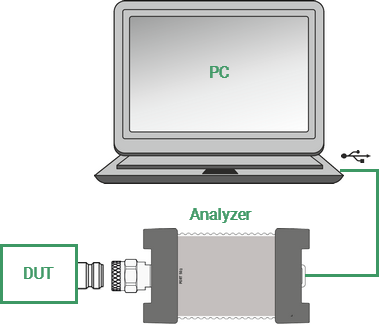This section represents a sample session of the Analyzer. It describes the main techniques of measurement of reflection coefficient parameters of the DUT. SWR and reflection coefficient phase of the DUT will be analyzed.
The instrument sends the stimulus to the input of the DUT and then receives the reflected wave. Generally, in the process of this measurement the output of the DUT should be terminated with a LOAD standard. The results of these measurements can be represented in various formats. The given example represents the measurement of SWR and reflection coefficient phase.
Typical circuit of DUT reflection coefficient measurement is shown in figure below.

Reflection Measurement Circuit
Measuring SWR and reflection coefficient phase:
•Prepare the Analyzer for reflection measurement.
•Set stimulus parameters (frequency range, number of sweep points).
•Set IF bandwidth.
•Set the number of traces to 2, assign measured parameters and display format to the traces.
•Set the scale of the traces.
•Perform calibration of the Analyzer for reflection coefficient measurement.
•Analyze SWR and reflection coefficient phase using markers.